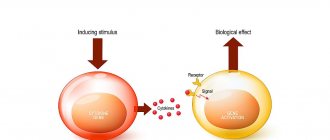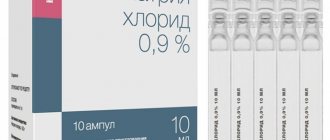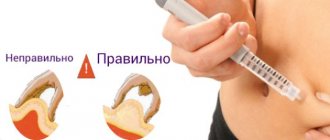Complexes with this research
Extended coagulogram Extended study of the functional state of hemostasis 4,150 ₽ Composition
Examination during pregnancy. 1st trimester 16,690 ₽ Composition
Coagulogram Study of the functional state of hemostasis RUB 2,020 Composition
IN OTHER COMPLEXES
- Examination during pregnancy. 3rd trimester 9,620 RUR
- Joining IVF RUB 23,020
- Pregnancy planning. Clinical indicators RUB 6,630
- Female infertility RUB 16,210
- Miscarriage RUB 40,070
Indications
Antithrombin III testing is most often carried out as part of a coagulogram in the following cases:
- Screening of patients at risk (there were cases of antithrombin deficiency in the family history, thrombosis of veins or arteries was observed before the age of 50);
- Estimation of the amount of functionally useful antithrombin III;
- Thromboembolic pathologies: thrombosis of deep veins or mesenteric vessels;
- myocardial infarction;
- pulmonary embolism;
- stroke;
- thrombophlebitis;
- miscarriage (history);
Detailed description of the study
During bleeding, platelets circulating in the blood plasma, with the participation of many clotting factors, form a clot. Along with this, under the influence of thrombin, the fibrin protein is formed, which stabilizes the formed blood clot, after which the bleeding stops.
Antithrombin III is a protein that regulates blood clotting. This protein prevents the formation of blood clots, which is necessary to maintain balance between the coagulation and anticoagulation systems. To this end, antithrombin III binds to enzymes called serine proteases, as well as thrombin, factor IXa and Xa, and inhibits their activity. Sufficient amounts of clotting factors and antithrombin III allow bleeding to be stopped without excessive clot formation.
Antithrombin III deficiency is associated with an increased risk of thrombosis and thromboembolism. It may be hereditary or acquired. According to various estimates, the prevalence of hereditary antithrombin III deficiency ranges from 1 in 2000 to 1 in 5000 cases.
Hereditary antithrombin deficiency is divided into type I and type II. Type I leads to the complete absence of this protein in the blood due to the absence of genes that ensure normal synthesis of antithrombin III. Type II deficiency is characterized by the production of altered protein, which impairs its function. The overall activity of antithrombin III decreases.
Lack of production or incomplete activity of antithrombin III most often manifests itself in the form of deep vein thrombosis. However, there is a risk of repeated sudden thrombosis of atypical vessels, for example, veins of the brain or intestines. The first occurrence of thrombosis occurs at a relatively young age, with the risk of blood clots peaking between the ages of 15 and 40 years. This is especially important against the background of concomitant factors that increase the risk of thrombosis, for example, during pregnancy.
Acquired deficiency of antithrombin III is usually associated with either a decrease in its production in the liver in the case of liver failure, cirrhosis, malnutrition, or with loss of protein by the body in nephrotic syndrome and some other conditions. A decrease in the concentration of antithrombin III is observed in coagulopathies, including disseminated intravascular coagulation syndrome, microangiopathy with thrombosis. In many malignant neoplasms, its production is also disrupted. The use of the anticoagulant heparin significantly increases the activity of antithrombin III, which makes it possible to prevent thrombosis.
The influence of antithrombin III on the body is extensive, so determining the level of this indicator in the blood allows you to avoid the negative consequences of its deficiency and select treatment.
Antithrombin III is a specific protein of the blood coagulation system. Its main function is to inactivate several major clotting factors, including thrombin, and prevent increased formation of blood clots (thrombi).
Synonyms Russian
AT III, AT3.
English synonyms
Antithrombin (Activity and Antigen), Functional Antithrombin III, AT III.
Research method
Colorimetric method.
Units
% (percent).
What biomaterial can be used for research?
Venous blood.
How to properly prepare for research?
- Do not eat for 12 hours before the test.
- Avoid physical and emotional stress 30 minutes before the test.
- Do not smoke for 30 minutes before the test.
General information about the study
Antithrombin III is synthesized mainly in the vascular endothelium and liver.
The blood is thin due to anticoagulants, one of which is antithrombin III, which blocks clotting factors.
Typically, when a vessel is damaged, the body activates a series of coagulative factors (coagulative cascade) to form a blood clot and prevent further blood loss. Antithrombin III helps regulate this process - it slows down the action of several coagulation factors, including thrombin, as well as factors Xa, IXa and Xia, designed to prevent the formation of excess blood clots.
Patients with antithrombin III deficiency are at risk for thrombosis. Inherited deficiency is rare (1 case in 5000 patients). If the patient has a genetic predisposition, thrombotic episodes usually make themselves felt already in 20-30 years.
There are two types of antithrombin III deficiency. In the first, normal antithrombin III is produced, but in insufficient quantities. In the second type, it is produced in sufficient quantities, but is dysfunctional. A decrease in antithrombin III levels can be caused by the following reasons:
- congenital antithrombin III deficiency,
- liver diseases with impairment of its functions (cirrhosis, cancer),
- nephrotic syndrome (diseases that occur with significant loss of protein in the urine),
- massive thrombosis (for example, pulmonary embolism),
- extensive surgical interventions,
- using large doses of oral contraceptives,
- long-term administration of heparin,
- DIC syndrome (severe disruption of all blood coagulation processes, which can occur in many critical conditions: shock, severe trauma, burns, massive thrombosis, etc.),
- extensive thrombosis,
- blood loss,
- oncological disease.
Regardless of the reasons for insufficient antithrombin III levels, its main manifestation is recurrent arterial and venous thrombosis.
Hereditary deficiency of antithrombin III is especially characterized by frequent myocardial infarctions and strokes at a young age.
What is the research used for?
- To determine whether the amount of functional antithrombin III in the blood is normal (before the antigen test).
- To evaluate patients whose body does not respond normally to heparin.
When is the study scheduled?
- Together with tests for protein C and protein S and for lupus anticoagulant.
- When a patient has venous thrombosis.
- After removal of the blood clot.
- When examining patients whose body does not respond normally to heparin, when it is necessary to use large doses of this drug to achieve the desired level of anticoagulation.
What do the results mean?
Reference values
| Age | Reference values |
| Less than 3 days | 58 — 90 % |
| 3 days – 1 month | 60 — 89 % |
| 1 month – year | 72 — 134 % |
| 1-6 years | 101 — 131 % |
| 6-11 years | 95 — 134 % |
| 11-16 years old | 96 — 126 % |
| More than 16 years | 66 — 124 % |
| Week of pregnancy | Reference values |
| 13-21st | 74 — 115 % |
| 21st-29th | 73 — 114 % |
| 29-35th | 76 — 112 % |
| 35-42nd | 70 — 116 % |
Increased antithrombin III levels are associated with an increased risk of bleeding.
Reasons for increased antithrombin III levels:
- long-term use of indirect anticoagulants (warfarin, phenylin),
- vitamin K deficiency,
- liver diseases,
- acute viral hepatitis,
- inflammatory process,
- menstruation.
Reasons for decreased antithrombin III levels:
- activation of the blood coagulation system - tendency to thrombotic complications,
- late stages of pregnancy,
- mid-menstrual cycle.
Reduced levels of antithrombin III in the blood can be caused by:
- body characteristics characteristic of the third trimester of pregnancy;
- chronic liver diseases (for example, liver failure);
- surgical interventions on the liver;
- nephrotic syndrome;
- malignant tumors;
- thrombotic microangiopathy;
- the patient taking oral contraceptives;
- prescribing certain enzymes (asparaginases) in the course of treatment;
- atherosclerosis;
- development of DIC syndrome (especially acute form);
- development of sepsis;
- development of thromboembolism.
Indications for prescribing an antithrombin test
- recurrent thrombosis in young people;
- recurrent miscarriage;
- preparation for surgery;
- taking oral contraceptives;
- the use of pharmaceuticals that inhibit the activity of the blood coagulation system (anticoagulants). As a rule, they are prescribed for severe injuries, during pregnancy, childbirth, and also after surgical interventions. Anticoagulants may be prescribed to prevent thrombosis during periods of prolonged inactivity.
Interpretation of results:
Inherited AT deficiency (less common) is often associated with thromboembolic disease, and acquired AT deficiency (more common) can occur with liver disease, kidney disease, metastatic cancer, and disseminated intravascular coagulation (DIC).
Related Products:
Hemostat Antithrombin liquid
The chromogenic test based on factor Xa allows the quantitative determination of functionally active antibodies even at low levels. Its advantage is that it:
• ready to use
• with reagent stability of 21-25 hours
• insensitive to heparin
References 1. Bhakuni, T., et al., Antithrombin III deficiency in Indian patients with deep vein thrombosis: identification of first India based AT variants including a novel point mutation (T280A) that leads to aggregation. PLoS One, 2015. 10(3): p. e0121889. 2. Khor, B. and E. M. Van Cott, Laboratory tests for antithrombin deficiency. Am J Hematol, 2010. 85(12): p. 947-50. 3. Bauer, K. A., T. M. Nguyen-Cao, and J. B. Spears, Issues in the Diagnosis and Management of Hereditary Antithrombin Deficiency. Ann Pharmacother, 2021. 50(9): p. 758-67. 4. Patnaik, M. M. and S. Moll, Inherited antithrombin deficiency: a review. Haemophilia, 2008. 14(6): p. 1229-39. 5. Funk, DM, Coagulation assays and anticoagulant monitoring. Hematology Am Soc Hematol Educ Program, 2012. 2012: p. 4605. 6. Thachil, J. and C. H. Toh, Current concepts in the management of disseminated intravascular coagulation. Thromb Res, 2012. 129 Suppl 1: p. S54-9.
Deficiency and excess of antithrombin III during pregnancy
From the very moment of conception, the body of a pregnant woman begins to prepare for childbirth. In this case, preparation occurs throughout the hemostatic system, which affects the state of the anticoagulant factor. To a greater extent, these changes are noticeable during the third trimester of pregnancy.
The body strives to prevent bleeding during labor, so it increases the level of clotting factors in the blood. Fibrinolytic activity of plasma decreases, the level of coagulation inhibitors, including antithrombin III, decreases. This becomes noticeable precisely towards the end of the third trimester. However, normally, the level of antithrombin III should not decrease to less than 65%.
Sometimes with hereditary deficiency of antithrombin III, its fall is erased, which cannot be determined in the laboratory. This is especially common during pregnancy, which is accompanied by severe toxicosis. This condition is dangerous because an artificial termination of pregnancy is possible, and after childbirth a woman may develop venous or arterial thrombosis, an infarction of internal organs or pulmonary embolism. Therefore, if a patient is at risk for this condition, she should be under special supervision by a doctor.
An increase in antithrombin III during pregnancy threatens the development of bleeding. This happens against the background of severe pathologies, for example with cholestasis or acute hepatitis.
What can distort the result
The following factors influence the results of the study:
- treatment with heparin and estrogens - they reduce the level of antithrombin in the blood;
- in the case of infectious, viral and inflammatory diseases (including influenza, ARVI, sore throat, rhinitis, etc.), the activity of antithrombin decreases, which also reduces its indicator.
Important! The interpretation of the results is always carried out comprehensively. It is impossible to make an accurate diagnosis based on only one analysis.
Qualitative and quantitative violations
Low antithrombin III levels are quite rare. According to statistics, there are no more than 1% of such people worldwide. However, of all the pathologies of the hematopoietic system, it is hereditary anticoagulant deficiency that is the most common disorder.
Congenital deficiency of antithrombin III (heterozygous form of the pathological gene) is manifested by the development of thrombosis in people aged 20-35 years. Triggering factors are: pregnancy, childbirth, previous operations or acute inflammation of internal organs, taking hormonal contraceptives. In the homozygous form, thrombosis will develop immediately after birth, but such a disorder is extremely rare.
Acquired antithrombin III deficiency can develop at any time, regardless of a person's age.
A person is not able to independently determine the existing coagulant deficiency, since there are no symptoms of the disorder. The only sign of this pathology will be the formation of thrombosis, but they develop not only with a lack of antithrombin III, but also with other disorders of the hematopoietic system. Moreover, blood clots can form in blood vessels even when the level of Ab III is normal. Simply with its structural changes, antithrombin may cease to perform its functions.
Therefore, quantitative antithrombin III deficiency and qualitative antithrombin III deficiency are distinguished. The first type of disorders is characterized by a low content of antithrombin III in the blood, and the second type is characterized by its functional inferiority. Moreover, in both of these conditions, thrombosis can develop. To find out what exactly led to the formation of blood clots in the vessels, a qualitative study of the antithrombin factor is required.
Exceeding the norm
- Acute infectious or inflammatory process;
- Diseases of the liver (viral hepatitis, cholestasis) and kidneys, transplantation of these organs;
- Pathologies of the pancreas (acute pancreatitis, oncology);
- Lack of vitamin K in the body;
- Menstrual bleeding (temporary increase, which should be considered normal);
- Therapy with indirect anticoagulants (for example, phenylin, warfarin), anabolic steroids.
Note:
an increase in antithrombin concentration indicates a risk of internal bleeding.
What does a deficiency and excess of antithrombin III indicate?
If a person has a decreased level of antithrombin III, this may indicate the following conditions:
- The woman took hormonal drugs for a long period of time to prevent unwanted pregnancy.
- Previous surgery or injury.
- A person is immobilized for a long time.
- Undergoing treatment with L-asparaginase.
- Taking heparin in high doses, which promotes the destruction of antithrombin III.
- Lack of ovulation in a woman of childbearing age.
- Heavy bleeding.
- Long-term use of corticosteroid drugs.
- Age-related hereditary thromboembolism and human genetic predisposition to antithrombin deficiency.
- DIC syndrome, consumption coagulopathy.
- Liver failure due to various diseases: cirrhosis, liver tumors, etc.
- The presence of a malignant tumor in the body.
- Thrombosis.
- Sepsis.
- State of shock.
- Introduction of drugs into the body to stop blood loss: fibrinogen, fibrinostat, cryoprecipitate.
- Nephrological syndrome in which there is excessive excretion of antithrombin III in the urine.
The following conditions can lead to an increase in the level of antithrombin III in the body:
- Viral hepatitis in the acute stage.
- Taking indirect anticoagulants.
- Vitamin K deficiency in the body.
- Cholestasis.
- Acute or chronic inflammation in the body.
- Taking anabolic hormones.




